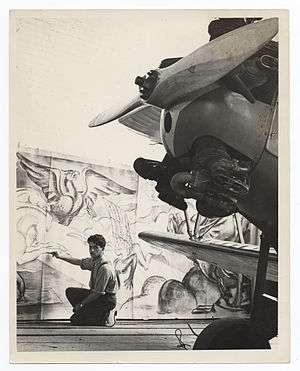Kinner K-5
| K-5 | |
|---|---|
 | |
| Kinner K-5 in a Fleet Model 2 | |
| Type | Radial engine |
| National origin | United States of America |
| Manufacturer | Kinner Airplane & Motor Corporation |
| Developed into | Kinner B-5 |
The Kinner K-5 was a popular engine for light general and sport aircraft developed by Winfield B. 'Bert' Kinner.[1] With the boom in civilian aviation after Charles Lindbergh's transatlantic flight the K-5 sold well. The K-5 was a rough running but reliable engine and the K-5 and its derivatives were produced in the thousands, powering many World War II trainer aircraft. The K-5 was followed by the B-5, R-5 and R-55. Military engines were designated R-370
Applications
- Adcox Special
- American Eagle A-129 biplane
- Chamberlin C-2
- Davis D-1-K
- Fleet Model 2
- Granville Brothers Model A biplane
- Kinner Sportster
- Kreutzer Air Coach
- Waco KSO
Specifications (Kinner K-5)
General characteristics
- Type: Five-cylinder, air-cooled, radial
- Bore: 4 1⁄4in (108mm)
- Stroke: 5 1⁄4in (133.3mm)
- Displacement: 372.4cuin (6.1 liters)
- Length: 19in (482mm)
- Height: 43.5in (1,104mm)
- Dry weight: 275lb (124kg)
Components
- Valvetrain: 1 inlet and 1 exhaust valve per cylinder
- Fuel system: 1 Stromberg carburetor
- Fuel type: 73 Octane
- Cooling system: Air
Performance
- Power output: 100hp at 1,810 rpm max/70hp at 1,650 rpm cruise
- Compression ratio: 5.0:1
- Power-to-weight ratio: 0.36 hp/lb at cruise
References
- ↑ "Winfield B. "Bert" Kinner Collection, 1919-1993". Retrieved 29 November 2010.
- http://www.oldengine.org/members/diesel/Duxford/usaero4.htm
- Gunston, Bill (1986). World Encyclopedia of Aero Engines. Wellingborough: Patrick Stephens. pp. 99–100.
This article is issued from Wikipedia - version of the 10/7/2015. The text is available under the Creative Commons Attribution/Share Alike but additional terms may apply for the media files.